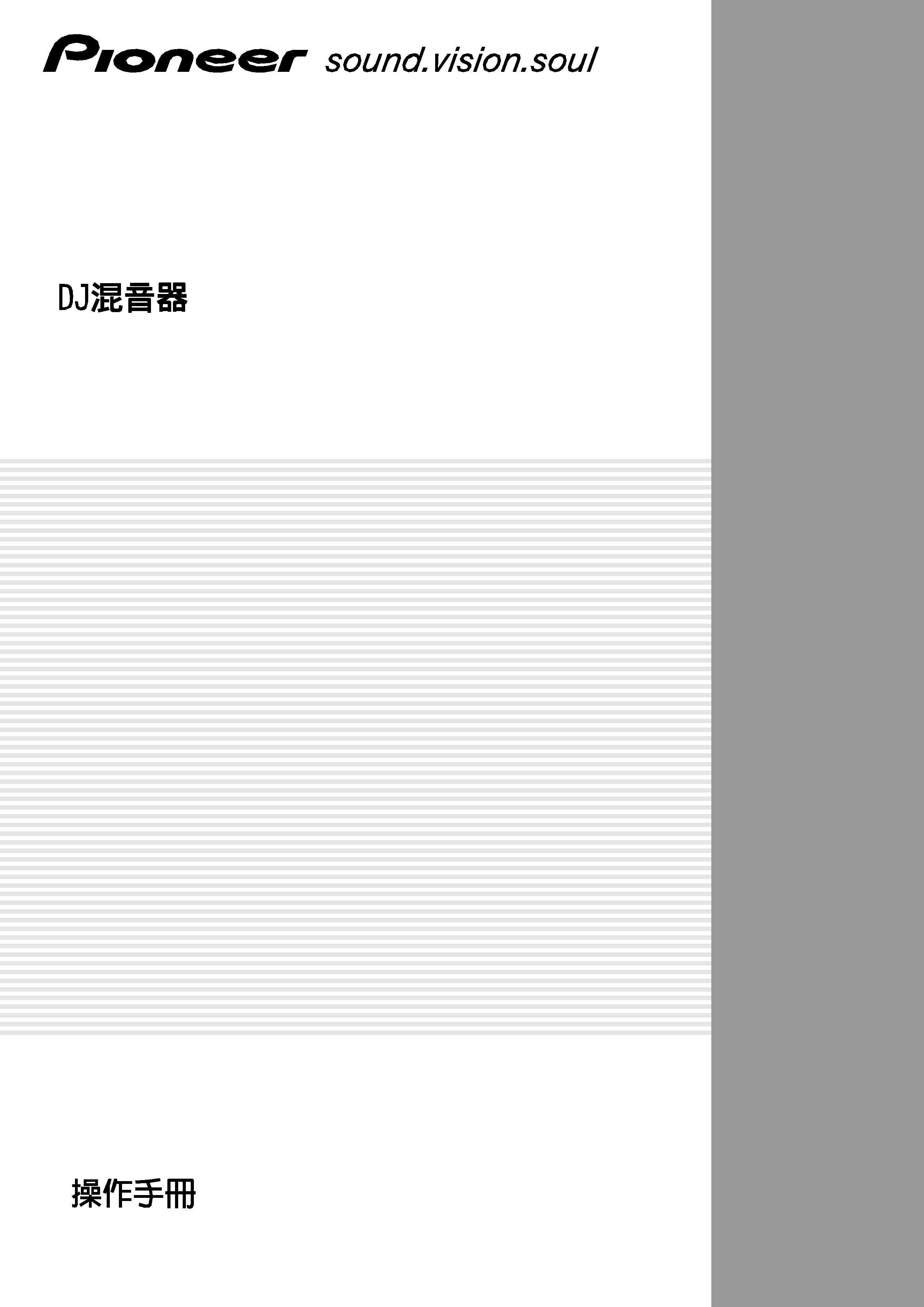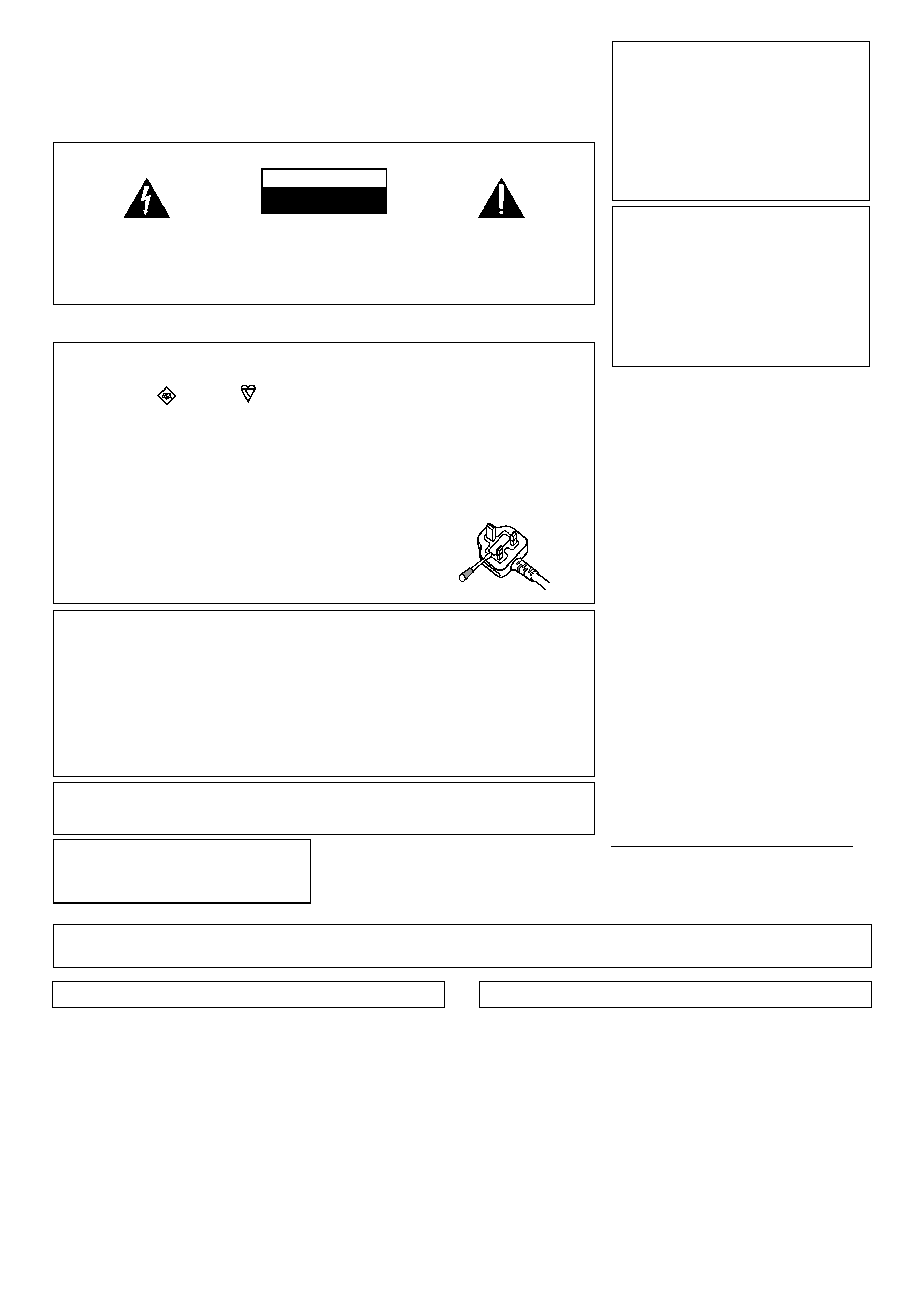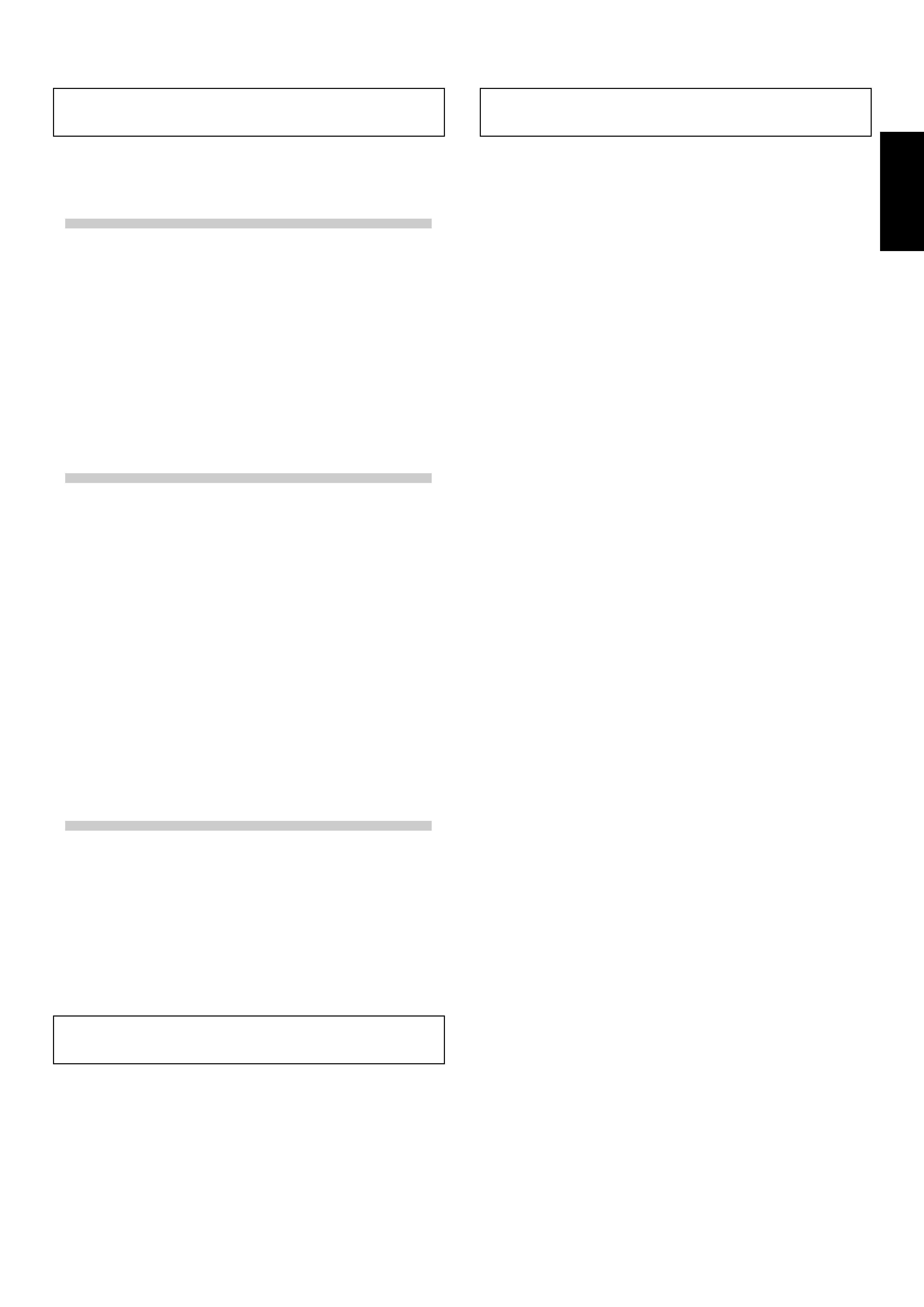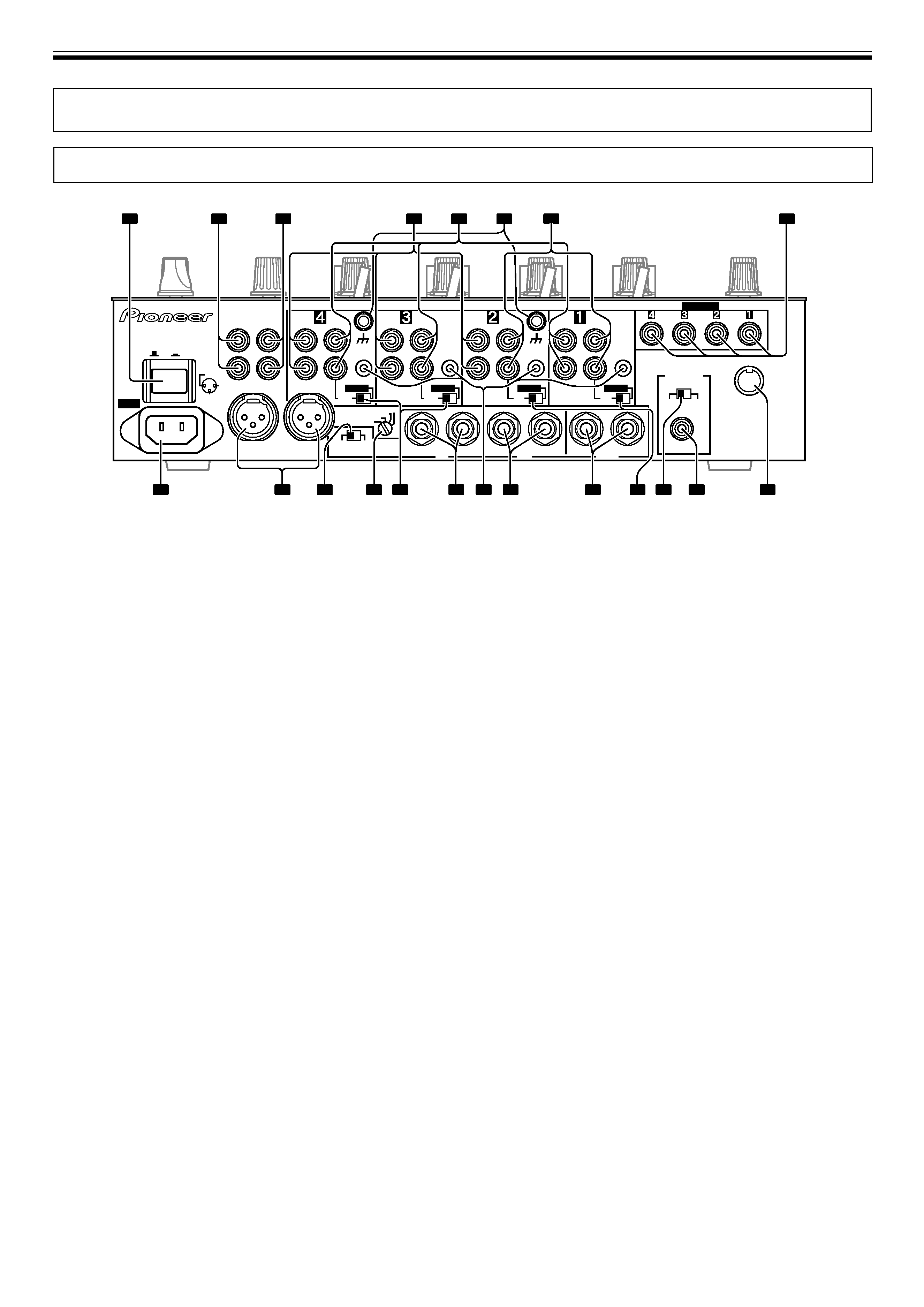
DJ MIXER
MESA DE MEZCLAS DJ
DJM-800
Operating Instructions
Manual de instrucciones

2
<DRB1394>
En
WARNING
This equipment is not waterproof. To prevent a fire
or shock hazard, do not place any container filed
with liquid near this equipment (such as a vase or
flower pot) or expose it to dripping, splashing, rain
or moisture.
D3-4-2-1-3_A_En
WARNING
The voltage of the available power supply differs
according to country or region. Be sure that the
power supply voltage of the area where this unit
will be used meets the required voltage (e.g., 230V
or 120V) written on the rear panel.
D3-4-2-1-4_A_En
Before plugging in for the first time, read the following
section carefully.
CAUTION: This product satisfies FCC regulations when shielded cables and connectors are used to connect the
unit to other equipment. To prevent electromagnetic interference with electric appliances such as radios and
televisions, use shielded cables and connectors for connections.
D8-10-3a_En
The exclamation point within an equilateral
triangle is intended to alert the user to the
presence of important operating and
maintenance (servicing) instructions in the
literature accompanying the appliance.
The lightning flash with arrowhead symbol,
within an equilateral triangle, is intended to
alert the user to the presence of uninsulated
"dangerous voltage" within the product's
enclosure that may be of sufficient
magnitude to constitute a risk of electric
shock to persons.
CAUTION:
TO PREVENT THE RISK OF ELECTRIC
SHOCK, DO NOT REMOVE COVER (OR
BACK). NO USER-SERVICEABLE PARTS
INSIDE. REFER SERVICING TO QUALIFIED
SERVICE PERSONNEL.
CAUTION
RISK OF ELECTRIC SHOCK
DO NOT OPEN
IMPORTANT
D3-4-2-1-1_En-A
WARNING
To prevent a fire hazard, do not place any naked
flame sources (such as a lighted candle) on the
equipment.
D3-4-2-1-7a_A_En
VENTILATION CAUTION
When installing this unit, make sure to leave space
around the unit for ventilation to improve heat
radiation (at least 5 cm at rear, and 3 cm at each
side).
WARNING
Slots and openings in the cabinet are provided for
ventilation to ensure reliable operation of the
product, and to protect it from overheating. To
prevent fire hazard, the openings should never be
blocked or covered with items (such as newspapers,
table-cloths, curtains) or by operating the
equipment on thick carpet or a bed.
D3-4-2-1-7b_A_En
Operating Environment
Operating environment temperature and humidity:
+5 ºC +35 ºC (+41 ºF +95 ºF); less than 85 %RH
(cooling vents not blocked)
Do not install this unit in a poorly ventilated area, or in
locations exposed to high humidity or direct sunlight (or
strong artificial light)
D3-4-2-1-7c_A_En
If the AC plug of this unit does not match the AC
outlet you want to use, the plug must be removed
and appropriate one fitted. Replacement and
mounting of an AC plug on the power supply cord of
this unit should be performed only by qualified
service personnel. If connected to an AC outlet, the
cut-off plug can cause severe electrical shock. Make
sure it is properly disposed of after removal.
The equipment should be disconnected by removing
the mains plug from the wall socket when left
unused for a long period of time (for example, when
on vacation).
D3-4-2-2-1a_A_En
CAUTION
The POWER switch on this unit will not completely
shut off all power from the AC outlet. Since the
power cord serves as the main disconnect device for
the unit, you will need to unplug it from the AC outlet
to shut down all power. Therefore, make sure the
unit has been installed so that the power cord can
be easily unplugged from the AC outlet in case of an
accident. To avoid fire hazard, the power cord should
also be unplugged from the AC outlet when left
unused for a long period of time (for example, when
on vacation).
D3-4-2-2-2a_A_En
Information to User
Alteration or modifications carried out without
appropriate authorization may invalidate the user's
right to operate the equipment.
D8-10-2_En
Thank you for buying this Pioneer product.
Please read through these operating instructions so you will know how to operate your
model properly. After you have finished reading the instructions, put them away in a safe
place for future reference.
In some countries or regions, the shape of the power plug and power outlet may some-
times differ from that shown in the explanatory drawings. However the method of connect-
ing and operating the unit is the same.
Location
Install the unit in a well-ventilated location where it will not
be exposed to high temperatures or humidity.
÷ Do not install the unit in a location which is exposed to
direct rays of the sun, or near stoves or radiators. Excessive
heat can adversely affect the cabinet and internal
components. Installation of the unit in a damp or dusty
environment may also result in a malfunction or accident.
(Avoid installation near cookers etc., where the unit may be
exposed to oily smoke, steam or heat.)
÷ When the unit is used inside a carrying case or DJ booth,
separate it from the walls or other equipment to improve
heat radiation.
CAUTIONS REGARDING HANDLING
Cleaning the Unit
÷ Use a polishing cloth to wipe off dust and dirt.
÷ When the surfaces are very dirty, wipe with a soft cloth
dipped in some neutral cleanser diluted five or six times
with water and wrung out well, then wipe again with a dry
cloth. Do not use furniture wax or cleaners.
÷ Never use thinners, benzene, insecticide sprays or other
chemicals on or near this unit, since these will corrode the
surfaces.
NOTE: This equipment has been tested and found to comply with the limits for a Class B digital device, pursuant to
Part 15 of the FCC Rules. These limits are designed to provide reasonable protection against harmful interference in
a residential installation. This equipment generates, uses, and can radiate radio frequency energy and, if not
installed and used in accordance with the instructions, may cause harmful interference to radio communications.
However, there is no guarantee that interference will not occur in a particular installation. If this equipment does
cause harmful interference to radio or television reception, which can be determined by turning the equipment off
and on, the user is encouraged to try to correct the interference by one or more of the following measures:
Reorient or relocate the receiving antenna.
Increase the separation between the equipment and receiver.
Connect the equipment into an outlet on a circuit different from that to which the receiver is connected.
Consult the dealer or an experienced radio/TV technician for help.
D8-10-1-2_En
Replacement and mounting of an AC plug on the power supply cord of this unit should be performed only by qualified
service personnel.
D3-4-2-1-2-2_B_En
IMPORTANT: THE MOULDED PLUG
This appliance is supplied with a moulded three pin mains plug for your safety and convenience. A 3 amp fuse is fitted in this plug. Should the
fuse need to be replaced, please ensure that the replacement fuse has a rating of 3 amps and that it is approved by ASTA or BSI to BS1362.
Check for the ASTA mark
or the BSI mark
on the body of the fuse.
If the plug contains a removable fuse cover, you must ensure that it is refitted when the fuse is replaced. If you lose the fuse cover the plug
must not be used until a replacement cover is obtained. A replacement fuse cover can be obtained from your local dealer.
If the fitted moulded plug is unsuitable for your socket outlet, then the fuse shall be removed and the plug cut off and disposed of
safely. There is a danger of severe electrical shock if the cut off plug is inserted into any 13 amp socket.
If a new plug is to be fitted, please observe the wiring code as shown below. If in any doubt, please consult a qualified electrician.
IMPORTANT: The wires in this mains lead are coloured in accordance with the following code:
Blue : Neutral
Brown : Live
As the colours of the wires in the mains lead of this appliance may not correspond with the coloured markings identifying the terminals in
your plug, proceed as follows ;
The wire which is coloured BLUE must be connected to the terminal which is marked with the
letter
N or coloured BLACK.
The wire which is coloured BROWN must be connected to the terminal which is marked with the
letter
L or coloured RED.
How to replace the fuse: Open the fuse compartment with a screwdriver and replace the fuse.

3
<DRB1394>
En
English
FEATURES
CONTENTS
CONFIRM ACCESSORIES
1 Designed for high sound quality
Analog signals are transmitted by the shortest circuitry and
converted to digital format at 96 kHz sampling rate via a 24-bit high
quality A/D converter. As a result, signals are passed to the digital
mixing stage in the best possible state. Mixing is performed with a
32-bit DSP, totally eliminating any loss in fidelity, while the ideal level
of filtering is introduced to produce optimum sound for DJ play.
These features are housed in a high-rigidity chassis with double-
shielded construction together with a high-performance power
section and other features of the high-fidelity technology also used in
the DJM-1000, thus guaranteeing the utmost in clear and powerful
club sounds.
2 Sound-color effects
1) Harmonic effect
Equipped with the industry's first "harmonic effect" function that
detects the track's key and provides optimum tuning for DJ play.
This new function allows smoother, more natural DJ mixing
compared to earlier models which allowed DJ play with track tempo
adjustment alone.
2) Modulation effect
"Filter," "crush," and "sweep" effects have been added to each
channel.
These allow a greater breadth to DJ play by permitting the user to
apply effects more intuitively.
Also, by combining these with "beat effects," some 50 kinds of effect
can be produced, giving the user a vast potential for remix and DJ
play.
3 Beat effects
The "beat effects" so popular on the DJM-600 are continued here.
Effects can be applied in linkage to the BPM (Beats Per Minute) count,
thus allowing the production of a variety of sounds.
Some of the effects include delay, echo, reverse delay, pan, trance,
filter, flanger, phaser, reverb, robot, chorus, roll, and reverse roll.
4 Digital IN/OUT
The digital input connectors support each of the sampling rates (44.1/
48/96 kHz), thus allowing the connection of digital components for a
DJ system with no sound degradation.
Likewise the digital output connectors support sampling rates 96 kHz/
24-bit and 48 kHz/24-bit, making the unit even more convenient for
cutting studio tracks or on other occasions when high sound fidelity
is required. (Only linear PCM is supported.)
5 MIDI OUT
Virtually all the dial and switch information of the DJM-800 can be
output in MIDI signal format, allowing external components to be
controlled via MIDI.
6 Other functions
¶ A control cable can be used to connect the unit to a Pioneer DJ CD
player, thus allowing playback to be linked to operation of the
fader ("fader start play").
¶ Built-in "3-band equalizer" supports level control within the range
of +6 dB to 26 dB in each bandwidth.
¶ "Cross fader assignment" function allows each channel's input to
be assigned flexibly to a cross fader.
¶ "Talk over" function automatically lowers track volume during
microphone input.
¶ "Fader curve adjustment" function allows modification of the
cross fader and channel fader curves.
¶ "Microphone cut" function mutes microphone output to the
booth monitor, thus preventing uncomfortable feedback.
¶ By replacing the channel fader section with the optional rotary
volume kit DJC-800RV, the slider control can be replayed with a
rotary type control.
CAUTIONS REGARDING HANDLING ........................ 2
CONFIRM ACCESSORIES ........................................... 3
FEATURES ................................................................... 3
BEFORE USING
CONNECTIONS ............................................................ 4
CONNECTION PANEL ........................................... 4
CONNECTING INPUTS .......................................... 5
CONNECTING EXTERNAL EFFECTORS,
OUTPUT CONNECTORS ....................................... 6
ABOUT MIDI CONNECTORS ................................ 6
CONNECTING MICROPHONE AND
HEADPHONES ........................................................ 7
CONNECTING THE POWER CORD ...................... 7
NAMES AND FUNCTIONS OF PARTS ...................... 8
OPERATION PANEL ............................................... 8
DISPLAY SECTION .............................................. 10
OPERATIONS
MIXER OPERATIONS ................................................ 12
BASIC OPERATIONS ........................................... 12
FADER START FUNCTION .................................. 13
EFFECT FUNCTIONS ................................................. 14
TYPES OF BEAT EFFECTS .................................. 14
PRODUCING BEAT EFFECTS .............................. 16
TYPE OF SOUND-COLOR EFFECT ..................... 17
USING SOUND-COLOR EFFECTS ...................... 17
EFFECT PARAMETERS ........................................ 18
MIDI SETTINGS ......................................................... 19
SYNCHRONIZING AUDIO SIGNALS TO
EXTERNAL SEQUENCER, OR USING
DJM-800 INFORMATION TO OPERATE
AN EXTERNAL SEQUENCER .............................. 19
MIDI MESSAGES ................................................. 19
PROGRAM CHANGE ........................................... 20
SNAPSHOT ........................................................... 20
OTHER
TROUBLESHOOTING ................................................ 21
SPECIFICATIONS ....................................................... 22
BLOCK DIAGRAM ...................................................... 68
Operating Instructions ........................................................... 1
Power cord ............................................................................. 1

4
<DRB1394>
En
CONNECTION PANEL
1. POWER switch
2. MASTER 2 output connectors
RCA type unbalanced output.
3. Recording output connectors (REC)
RCA type output connectors for recording.
4. PHONO input connectors
RCA type phono level (MM cartridge) input connectors.
Do not use for inputting line level signals.
5. LINE input connectors
RCA type line level input connectors.
Use to connect a cassette deck or other line level output component.
6. Signal grounding terminals (SIGNAL GND)
Use to connect ground wires from analog players.
This is not a safety grounding terminal.
7. CD input connectors
RCA type line level input connectors.
Use to connect a DJ CD player or other line level output component.
8. DIGITAL IN connectors
RCA type digital coaxial input connectors.
Use to connect to DJ CD player or other digital coaxial output
connectors.
9. MIDI OUT connector
DIN type output connector.
Use to connect to other MIDI component (see P. 19).
10. DIGITAL OUT connector
RCA type digital coaxial output connector.
Master audio digital output.
11. Sampling frequency selector switch (fs 48 k/96 k)
Use to set the sampling frequency of the digital output to 96 kHz/24-
bit or 48 kHz/24-bit.
12. DIGITAL/CD input selector switches
Use to select either analog input (CD) or digital input (DIGITAL IN).
13. RETURN connectors
Ø6.3 mm phone-type input connectors.
Use to connect to the output connectors of external effectors or
similar components.
When the L channel only is connected, the L channel input is
simultaneously input to the R channel.
14. SEND output connectors
Ø6.3 mm phone-type output connectors.
Use to connect to the input connectors of external effectors or other
similar components. When the L channel only is connected, a L+R
monaural signal is output.
15. CONTROL connectors
Ø3.5 mm mini-connector. Use to connect to the control connector of
a Pioneer DJ CD player.
When the connectors are connected, the DJM-800's fader can be
used to perform start/stop on the DJ CD player.
16. BOOTH monitor output connectors
Ø6.3 mm phone-type booth monitor output connectors.
The sound level from these connectors is controlled independently
by the BOOTH MONITOR level dial, regardless of the position of the
MASTER LEVEL dial. (These connectors are TRS output, so they
support both balanced and unbalanced outputs.)
17. DIGITAL/LINE input selector switches
Use to select either analog input (LINE) or digital input (DIGITAL IN).
18. Master output attenuator switch (MASTER ATT)
Use to attenuate the level of the master 1 and master 2 outputs.
Selectable values are 0 dB, 3 dB, 6 dB and 12 dB.
19. Microphone signal switch
(MIC SIGNAL ADD/CUT)
When set to the [ADD] position, the sounds from microphone 1 and
microphone 2 are output to the BOOTH monitor output connectors.
When set to the [CUT] position, the sounds from microphone 1 and
microphone 2 are not output to the BOOTH monitor output
connectors.
20. MASTER 1 output connectors
XLR type (male) balanced output.
÷ When using a cord with RCA-type plug, users are recommended
to connect the plug directly to the MASTER 2 connectors without
using an XLR/RCA converter plug.
21. Power inlet (AC IN)
Use the accessory power cord to connect to an AC power outlet of the
proper voltage.
CONNECTIONS
CONNECTIONS (CONNECTION PANEL)
POWER
MASTER 2
REC
RL
R
(TRS)
L
MASTER 1
L
R
PHONO
CONTROL
DIGITAL
MIC SIGNAL
CUT
ADD
SIGNAL GND
SIGNAL GND
LINE
DIGITAL
LINE
DIGITAL
CD
DIGITAL
CD
LINE
L
R
AC IN
OFF
ON
1GND
3COLD
MASTER ATT
2HOT
PHONO
CONTROL
BOOTH
R
L(MONO)
SEND
R
L(MONO)
RETURN
LINE
L
R
PHONO
CONTROL
CD
L
R
LINE
CONTROL
DIGITAL OUT
MIDI OUT
fs (Hz)
48 k
96 k
CD
L
R
-12dB
-6dB
-3dB
0dB
DIGITAL IN
1
2
3
4
5
6
8
9
10
11
13
12
14
15
16
17
18
19
20
21
7

5
<DRB1394>
En
English
POWER
MASTER 2
REC
RL
R
(TRS)
L
MASTER 1
L
R
PHONO
CONTROL
DIGITAL
MIC SIGNAL
CUT
ADD
SIGNAL GND
SIGNAL GND
LINE
DIGITAL
LINE
DIGITAL
CD
DIGITAL
CD
LINE
L
R
AC IN
OFF
ON
1GND
3COLD
MASTER ATT
2HOT
PHONO
CONTROL
BOOTH
R
L(MONO)
SEND
R
L(MONO)
RETURN
LINE
L
R
PHONO
CONTROL
CD
L
R
LINE
CONTROL
DIGITAL OUT
MIDI OUT
fs (Hz)
48 k
96 k
CD
L
R
-12dB
-6dB
-3dB
0dB
DIGITAL IN
L
R
L
R
L
R
L
R
L
R
L
R
Always turn off the power switch and disconnect the power plug from its outlet when making or changing connections.
CONNECTING INPUTS
Pioneer DJ CD players
Connect a DJ CD player's audio output connectors to one of the
channel 1 to 2 CD input connectors or the channel 3 to 4 LINE input
connectors, and connect the player's control cable to the
corresponding channel's CONTROL connector.
Set the connected channel's DIGITAL/CD switch or DIGITAL/LINE
switch to either [CD] or [LINE], and set the input selector switch to
[CD/DIGITAL] or [LINE/DIGITAL].
When making digital connections, connect the digital coaxial output
terminal of the DJ CD player to one of the channel 1 to 4 DIGITAL IN
connectors of the DJM-800; then set the corresponding channel's
DIGITAL/CD switch or DIGITAL/LINE switch to [DIGITAL], and the
input selector switch to [CD/DIGITAL] or [LINE/DIGITAL].
Analog turntable
To connect an analog turntable, connect the turntable's audio
output cable to one of the channel 2 to 4 PHONO input connectors.
Set the corresponding channel's input selector switch to [PHONO].
The DJM-800's PHONO inputs support MM cartridges.
Connect the turntable's ground wire to one of the DJM-800's
SIGNAL GND terminals.
÷ Note that no PHONO input connector is provided for channel 1.
Connecting other line level output devices
To use a cassette deck or other CD player, connect the component's
audio output connectors to one of the channel 3 to 4 LINE input
connectors. Then set the corresponding channel's DIGITAL/LINE
switch to [LINE], and the input selector switch to [LINE/DIGITAL].
Alternately, connect the component to the channel 1 LINE input
connector, then set the channel 1 input selector switch to [LINE].
Connecting other digital output devices
To use a CD player or other component with digital connections,
connect the component's digital coaxial output connectors to one of
the channel 1 to 4 DIGITAL IN connectors; then set the corresponding
channel's DIGITAL/CD switch or DIGITAL/LINE switch to [DIGITAL],
and the input selector switch to [CD/DIGITAL] or [LINE/DIGITAL].
Input selector switch
DIGITAL/CD switch
Analog turntable
DJ CD player
CD player, etc.
Cassette deck, etc.
Analog turntable
DJ CD player
CONNECTIONS (CONNECTING INPUTS)
DIGITAL/LINE switch
